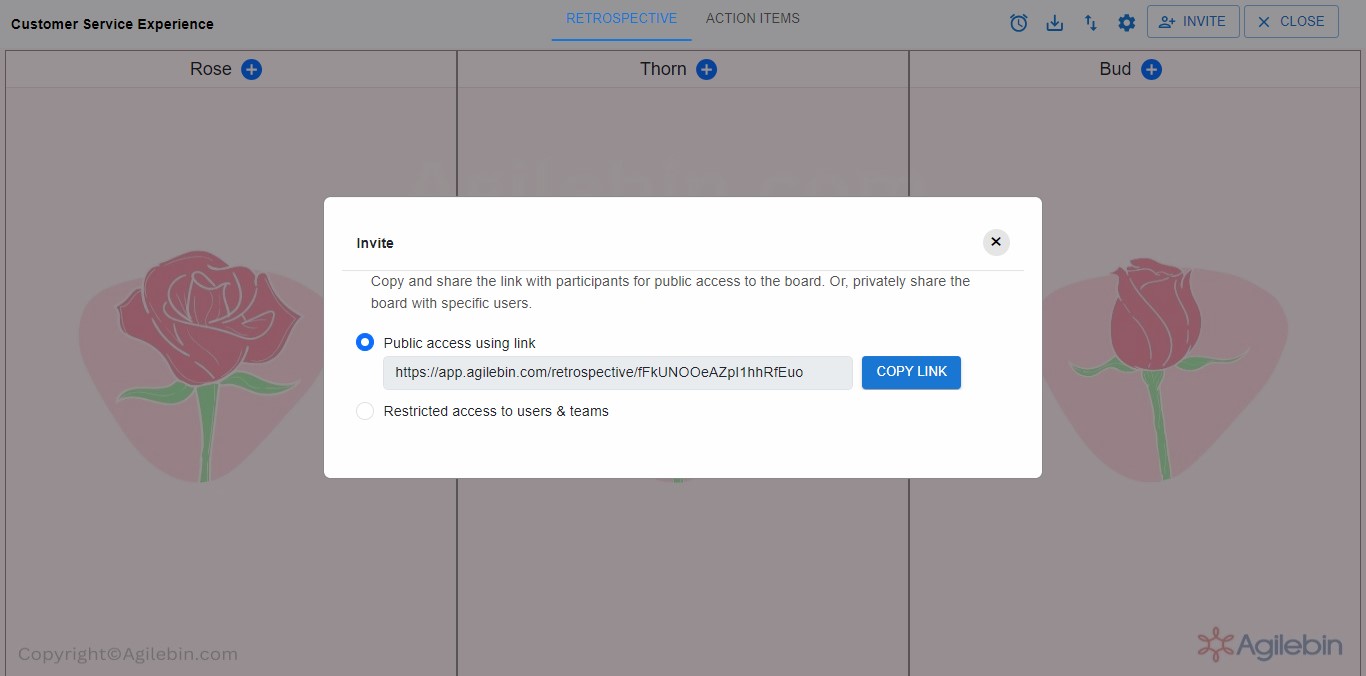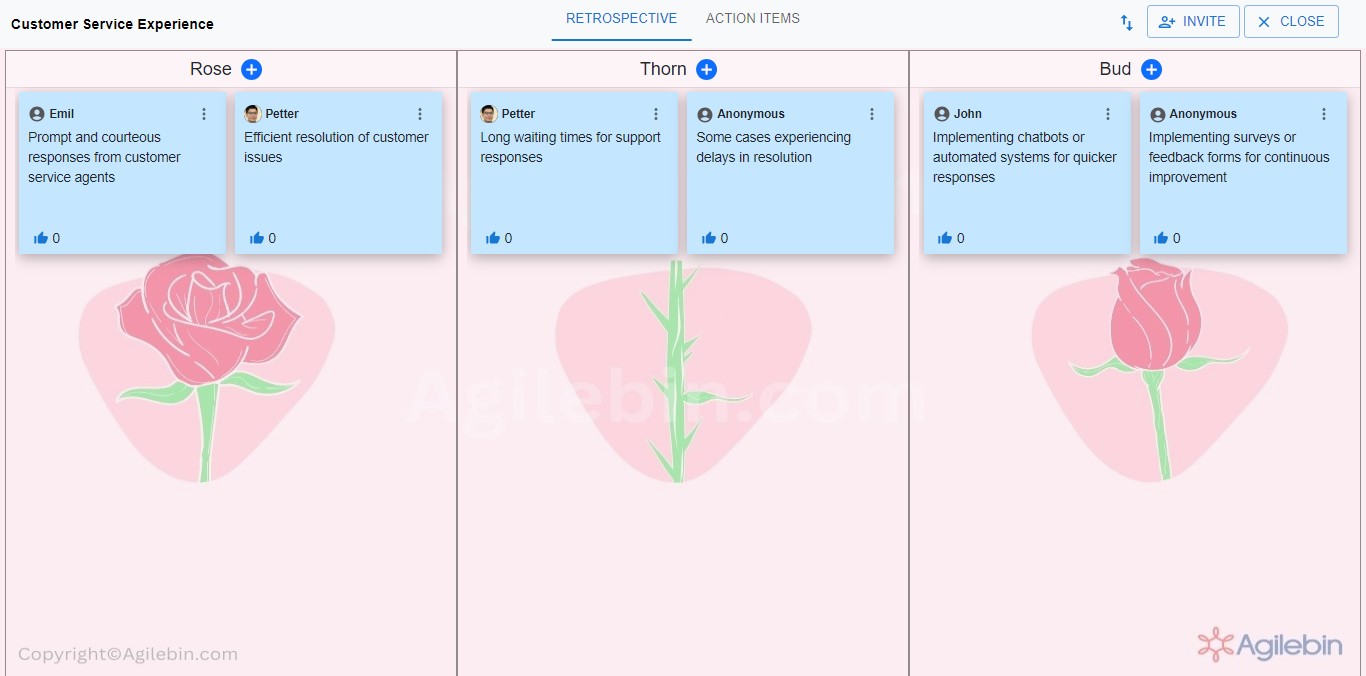Rose Thorn Bud Retrospective
Team reflects on positives (Rose), negatives (Thorn), and opportunities (Bud) for improvement

What is Rose Thorn Bud Retrospective?
The "Rose, Thorn, Bud" retrospective is a widely-used technique in agile methodologies like Scrum. It's a collaborative exercise where team members reflect on a recent period, typically a sprint, to identify positive aspects (Rose), negative aspects (Thorn), and potential areas for growth or improvement (Bud). This retrospective fosters open communication within the team, allowing members to share successes, challenges, and ideas for enhancement. By acknowledging both achievements and obstacles, teams can learn from their experiences and continuously refine their processes for greater efficiency and effectiveness.
How to Run Rose Thorn Bud Retrospective?
Running a Rose, Thorn, Bud retrospective is a straightforward process. Here's a step-by-step guide
- Set the Stage: Begin by explaining the purpose of the retrospective to the team. Emphasize that it's an opportunity for everyone to reflect on the recent period and identify what went well, what didn't, and what improvements can be made.
- Create a Safe Environment: Ensure that all team members feel comfortable sharing their thoughts and opinions. Remind everyone that the retrospective is a judgment-free zone where constructive feedback is encouraged.
- Gather Input: Provide each team member with sticky notes or index cards and markers. Ask them to write down their Roses (positives), Thorns (negatives), and Buds (opportunities for improvement) from the sprint or period being discussed. Encourage them to be specific and provide examples whenever possible.
- Share and Discuss: Once everyone has written down their thoughts, have each team member share one item from each category. As they share, encourage discussion and clarification to ensure everyone understands the context behind each point.
- Group Similar Items: As items are shared, group together any similar Roses, Thorns, or Buds. This helps to identify common themes and priorities within the team.
- Reflect and Prioritize: After all items have been shared and discussed, take some time as a team to reflect on the insights gained. Discuss which items are most significant and prioritize them based on their potential impact on future work.
- Identify Action Items: From the prioritized list of Thorns and Buds, work together as a team to identify specific action items or improvements that can be implemented in the next sprint or period. Assign owners to each action item to ensure accountability.
- Wrap Up: Conclude the retrospective by summarizing the key takeaways and action items. Thank everyone for their participation and remind them that feedback and continuous improvement are essential for the team's success.
- Follow Up: Keep track of the action items identified during the retrospective and follow up on their progress in future meetings. This ensures that the team remains accountable for implementing the identified improvements.
Columns in Rose Thorn Bud Retrospective
Typically, the retrospective is divided into three columns:
- Rose: This column captures the highlights and successes of the period under review. It's where team members celebrate achievements, positive outcomes, and instances of effective teamwork. Roses can range from completing tasks ahead of schedule, overcoming obstacles, delivering high-quality work, to receiving positive feedback from stakeholders or customers. By acknowledging and appreciating these accomplishments, team morale is boosted, and successes are reinforced.
- Thorn: In this column, team members candidly discuss challenges, setbacks, or obstacles encountered during the period. Thorns can include issues with communication, bottlenecks in the workflow, technical difficulties, conflicts within the team, or any other factors that impeded progress. Identifying and acknowledging these challenges is crucial for learning and improvement, as it allows the team to address underlying issues and prevent similar problems in the future.
- Bud: The Bud column focuses on opportunities for growth, improvement, and innovation. Here, team members brainstorm potential areas where the team can evolve or enhance its processes, practices, or products. Buds can stem from lessons learned from Thorns, emerging trends or technologies, feedback from stakeholders, or creative ideas from team members. By nurturing these budding opportunities, the team can continuously adapt and innovate, driving long-term success and competitiveness.
When to do a Rose Thorn Bud Retrospective
A Rose, Thorn, Bud retrospective can be conducted at various points in a project lifecycle, typically at the end of a predefined period such as a sprint in agile methodologies like Scrum. Here are some common scenarios for conducting a Rose, Thorn, Bud retrospective:
- End of a Sprint: In Scrum, teams often conduct retrospectives at the end of each sprint, which is typically a timeboxed period ranging from one to four weeks. This allows the team to reflect on their performance during the sprint, identify successes, challenges, and opportunities for improvement, and make adjustments before starting the next sprint.
- Project Milestones: Retrospectives can also be conducted at significant milestones or checkpoints within a project. This could be after completing a major phase of development, reaching a key deliverable, or at the end of a project iteration. It provides an opportunity for the team to reflect on progress, assess outcomes, and adjust strategies as needed.
- Quarterly or Periodic Reviews: Some teams prefer to conduct retrospectives on a regular basis, such as quarterly or bi-monthly. This allows for a more comprehensive review of performance over a longer period, enabling the team to identify trends, patterns, and recurring issues that may require attention.
- After Significant Events or Changes: Retrospectives can also be valuable after significant events or changes within the team or project, such as the introduction of new team members, changes in project scope, or the adoption of new tools or processes. It provides an opportunity to assess the impact of these changes and make any necessary adjustments.
- As Needed: Finally, retrospectives can be conducted ad-hoc whenever the team feels it's necessary to reflect on their performance, address specific issues, or capitalize on emerging opportunities. This flexible approach allows teams to adapt to changing circumstances and maintain a focus on continuous improvement.
How can you conduct a Rose Thorn Bud retrospective with Agilebin?
Effortlessly conduct a Rose Thorn Bud retrospective with Agilebin's ready-to-use template!
Why Agilebin's template? Because it provides a realistic and immersive experience, making your Rose Thorn Bud retrospective feel authentic and meaningful. With Agilebin's ready-to-use template, you'll feel like you're navigating through the actual process, allowing for a more effective and insightful retrospective session.
Choose Rose Thorn Bud retrospective template in Agilebin
Choose the Rose Thorn Bud Retrospective template from Agilebin's collection of retrospective templates. This template is specifically designed to facilitate the Rose Thorn Bud Retrospective process, providing a structured framework for your team's reflection and improvement discussions
Invite team members to participate in the retrospective session
Invite team members to participate in the retrospective session by adding their email addresses or sharing the session link directly with them. You can choose between public access using a link, allowing anyone with the link to join, or restricted access, limiting participation to specific users or teams.

Facilitate Discussion with Sticky Notes
Agilebin offers pre-defined columns for the Rose Thorn Bud Retrospective, including 'Rose', 'Thorn', 'Bud'. Participants can add sticky notes to each column during the retrospective session, sharing their feedback, observations, and suggestions
